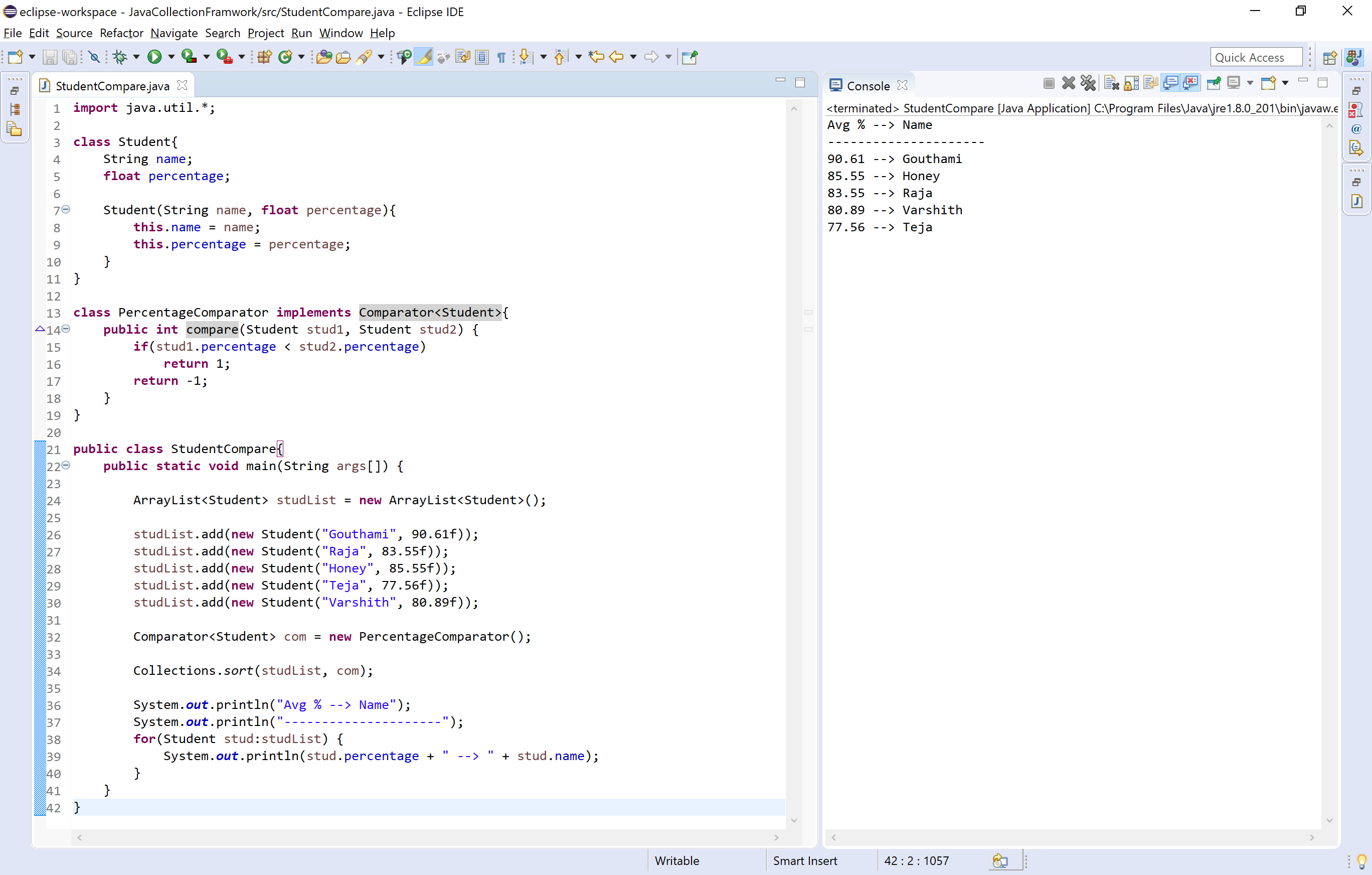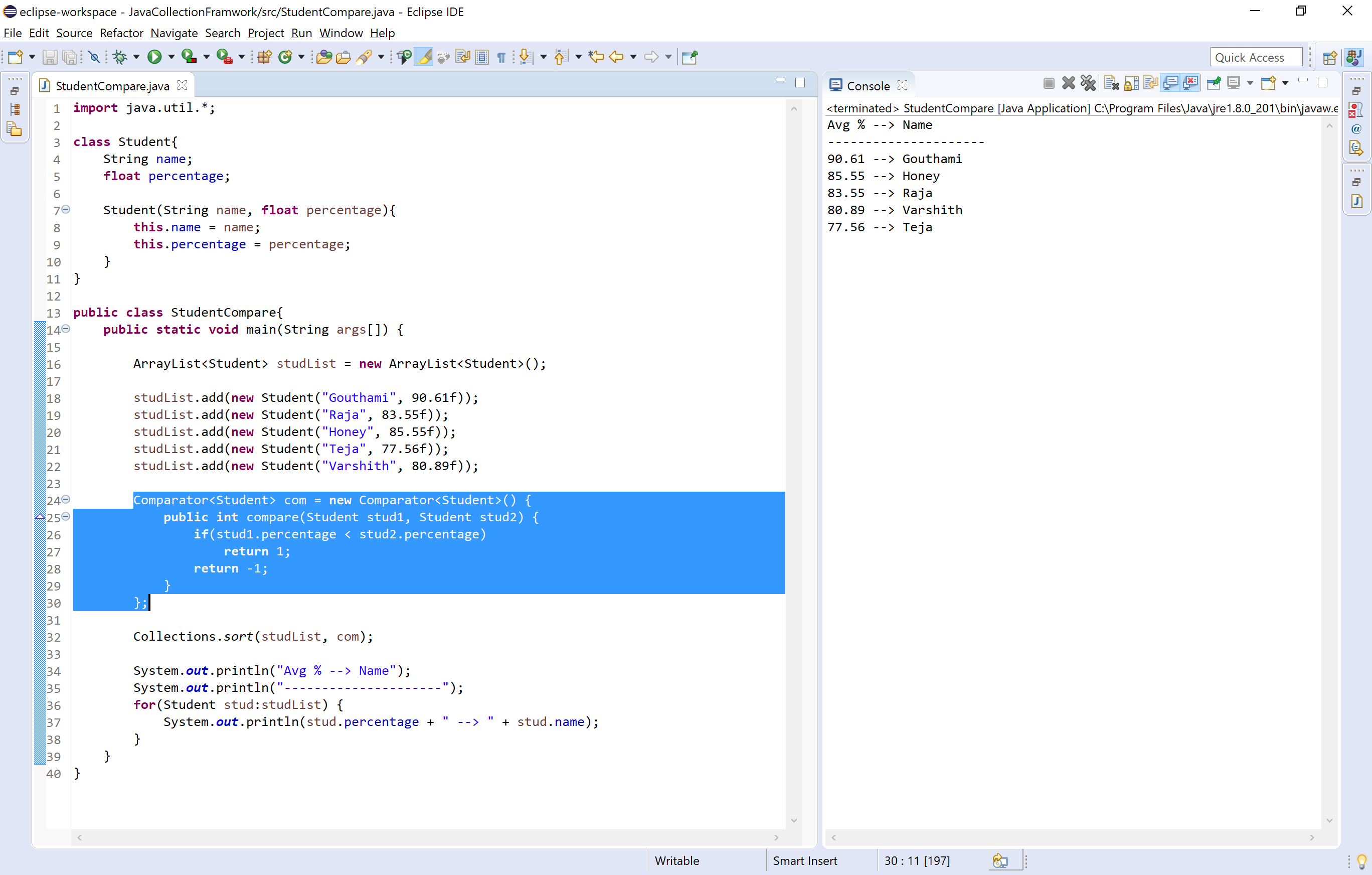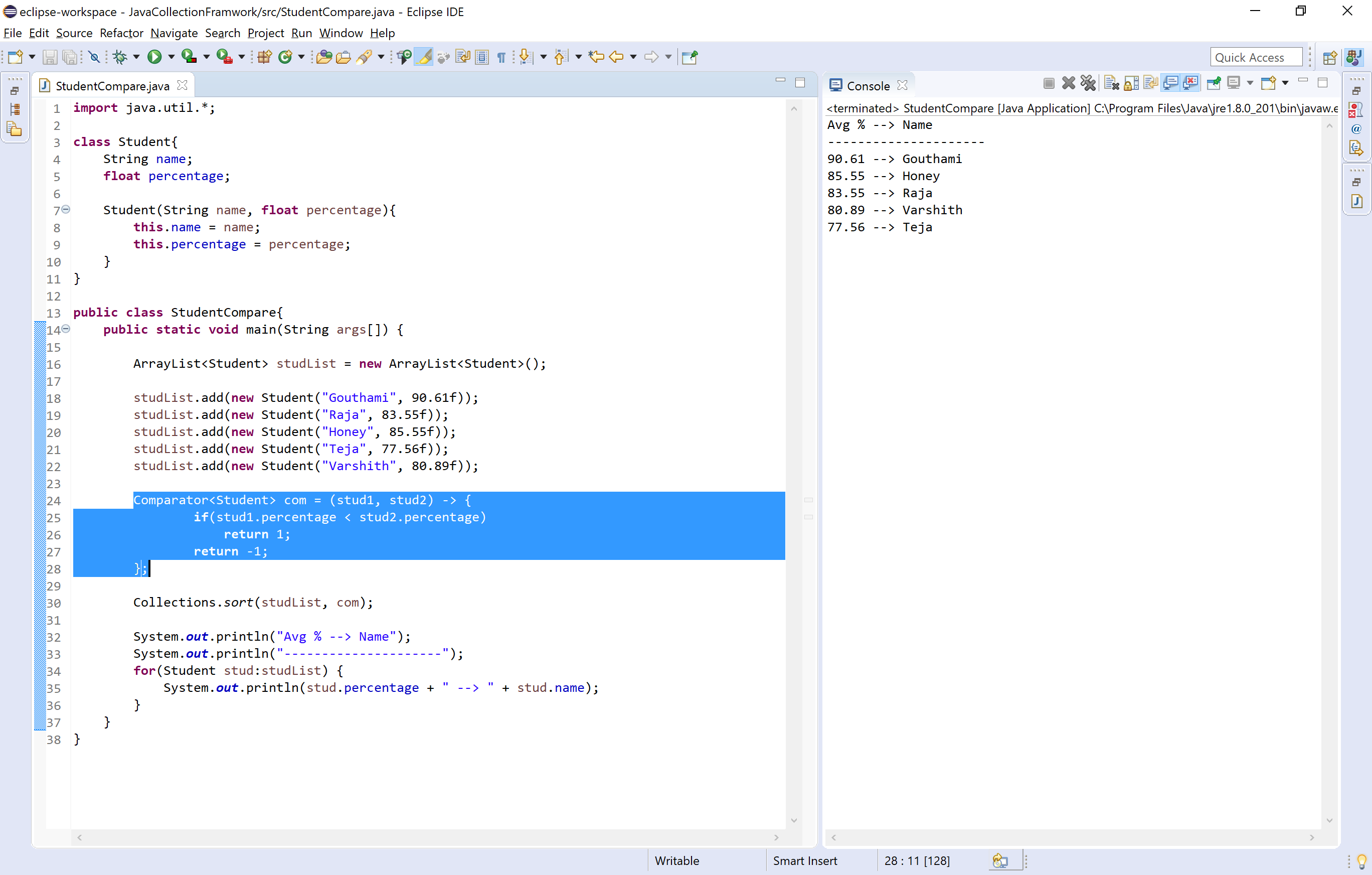Comparators in java
The Comparator is an interface available in the java.util package. The java Comparator is used to order the objects of user-defined classes. The java Comparator can compare two objects from two different classes.
Using the java Comparator, we can sort the elements based on data members of a class. For example, we can sort based on roolNo, age, salary, marks, etc.
The Comparator interface has the following methods.
| Method | Description |
|---|---|
| int compare(Object obj1, Object obj2) | It is used to compares the obj1 with o bj2 . |
| boolean equals(Object obj) | It is used to check the equity between current object and argumented object. |
The Comparator can be used in the following three ways.
- Using a seperate class that implements Comparator interface.
- Using anonymous class.
- Using lamda expression.
Using a seperate class
We use the following steps to use Comparator with a seperate class.
- Step - 1: Create the user-defined class.
- Step - 2: Create a class that implements Comparator interface.
- Step - 3: Implement the comapare( ) method of Comparator interface inside the above defined class(step - 2).
- Step - 4: Create the actual class where we use the Compatator object with sort method of Collections class.
- Step - 5: Create the object of Compatator interface using the class crearted in step - 2.
- Step - 6: Call the sort method of Collections class by passing the object created in step - 6.
- Step - 7: Use a for-each (any loop) to print the sorted information.
Let's consider an example program to illustrate Comparator using a separate class.
import java.util.*;
class Student{
String name;
float percentage;
Student(String name, float percentage){
this.name = name;
this.percentage = percentage;
}
}
class PercentageComparator implements Comparator<Student>{
public int compare(Student stud1, Student stud2) {
if(stud1.percentage < stud2.percentage)
return 1;
return -1;
}
}
public class StudentCompare{
public static void main(String args[]) {
ArrayList<Student> studList = new ArrayList<Student>();
studList.add(new Student("Gouthami", 90.61f));
studList.add(new Student("Raja", 83.55f));
studList.add(new Student("Honey", 85.55f));
studList.add(new Student("Teja", 77.56f));
studList.add(new Student("Varshith", 80.89f));
Comparator<Student> com = new PercentageComparator();
Collections.sort(studList, com);
System.out.println("Avg % --> Name");
System.out.println("---------------------");
for(Student stud:studList) {
System.out.println(stud.percentage + " --> " + stud.name);
}
}
}

Using anonymous class
We use the following steps to use Comparator with anonymous class.
- Step - 1: Create the user-defined class.
- Step - 2: Create the actual class where we use the Compatator object with sort method of Collections class.
- Step - 3: Create the object of Compatator interface using anonymous class and implement compare method of Comparator interface.
- Step - 4: Call the sort method of Collections class by passing the object created in step - 6.
- Step - 5: Use a for-each (any loop) to print the sorted information.
Let's consider an example program to illustrate Comparator using a separate class.
import java.util.*;
class Student{
String name;
float percentage;
Student(String name, float percentage){
this.name = name;
this.percentage = percentage;
}
}
public class StudentCompare{
public static void main(String args[]) {
ArrayList<Student> studList = new ArrayList<Student>();
studList.add(new Student("Gouthami", 90.61f));
studList.add(new Student("Raja", 83.55f));
studList.add(new Student("Honey", 85.55f));
studList.add(new Student("Teja", 77.56f));
studList.add(new Student("Varshith", 80.89f));
Comparator<Student> com = new Comparator<Student>() {
public int compare(Student stud1, Student stud2) {
if(stud1.percentage < stud2.percentage)
return 1;
return -1;
}
};
Collections.sort(studList, com);
System.out.println("Avg % --> Name");
System.out.println("---------------------");
for(Student stud:studList) {
System.out.println(stud.percentage + " --> " + stud.name);
}
}
}

Using lamda expression
We use the following steps to use Comparator with lamda expression.
- Step - 1: Create the user-defined class.
- Step - 2: Create the actual class where we use the Compatator object with sort method of Collections class.
- Step - 3: Create the object of Compatator interface using lamda expression and implement the code for compare method of Comparator interface.
- Step - 4: Call the sort method of Collections class by passing the object created in step - 6.
- Step - 5: Use a for-each (any loop) to print the sorted information.
Let's consider an example program to illustrate Comparator using a separate class.
import java.util.*;
class Student{
String name;
float percentage;
Student(String name, float percentage){
this.name = name;
this.percentage = percentage;
}
}
public class StudentCompare{
public static void main(String args[]) {
ArrayList<Student> studList = new ArrayList<Student>();
studList.add(new Student("Gouthami", 90.61f));
studList.add(new Student("Raja", 83.55f));
studList.add(new Student("Honey", 85.55f));
studList.add(new Student("Teja", 77.56f));
studList.add(new Student("Varshith", 80.89f));
Comparator<Student> com = (stud1, stud2) -> {
if(stud1.percentage < stud2.percentage)
return 1;
return -1;
};
Collections.sort(studList, com);
System.out.println("Avg % --> Name");
System.out.println("---------------------");
for(Student stud:studList) {
System.out.println(stud.percentage + " --> " + stud.name);
}
}
}

